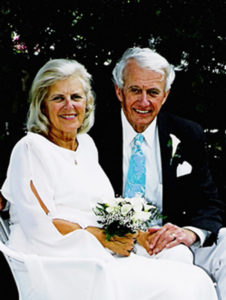Bob and Judie Terry are not only veterans of the Peace Corps — which celebrates its 50th anniversary this year — they actually met at a National Peace Corps Association meeting. Judie (whose mother was one of the first female pilots in the United States) had always had a longing for far-off places and for service to others, and so in mid-life she sold her highly successful real estate business and became a Peace Corps Volunteer. In Honduras Judie helped entrepreneurs (many of them women) develop business plans for shrimp farms, garlic farms, banks, and even a radio talk show.
The Peace Corps |
Once back in the States, like so many returned volunteers, Judie remained active with the Boston-area Peace Corps veterans, eventually serving on the National Peace Corps Association Board. At one meeting she saw “a good looking man walking across the stage.” That was Bob Terry. Two years later Judie and Bob, both Massachusetts natives, were married.
Bob believes he was perhaps “genetically predisposed” toward international experiences. His grandfather — T. Philip Terry (1864-1945) — as a young man in the 1880s had “worked his way to Mexico City,” where, seeing the surge of gringo turistas, he put together the popular Spanish-English Pocket Interpreter (1891) and then Terry’s Guide to Mexico (11 editions, 1909-1972).
Bob himself, during college, set off to Mexico one summer with a Quaker-sponsored team to teach English in a Mexican village. Back in college, he devoured Mexican history. After he received his Harvard degree in history and literature, Bob served three years in the Navy, and then headed to India and Pakistan where he wrote for both Indian and American papers. Returning to the States two years later, he completed a Masters Degree at The Fletcher School of Law & Diplomacy at Tufts University and then another Masters at the Harvard Graduate School of Public Administration, now called the Harvard Kennedy School.
By now, Bob had spent much of his young adult life studying rural development — often first hand. Along with Sargent Shriver, Bob was part of the educational exchange institution called The Experiment in International Living. When Shriver was appointed by John F. Kennedy to be the Founding Director of the Peace Corps, he picked Terry to lead the very first team (1961) of volunteers sent to mainland Asia — East Pakistan (now called Bangladesh). His team spent three months intensively studying Bengali language and culture, and then off they went: engineers, agricultural workers, teachers, nurses, mechanics, a bricklayer, even a doctor.
Bob eventually went to work for Arthur D. Little, the oldest technology and management firm in the world, as a consultant. He did this for 27 years, which included 20 years assisting development agencies in Bangladesh and 20 years teaching in the Arthur D. Little Management Education Institute.
With retirement time approaching, Bob and Judie had some very important decisions to make. They wanted to spend their summers in Cambridge and Cape Cod, but they wanted to spend their winters in a warmer climate. Knowledgeable about retirement opportunities throughout the world, they struggled over what would be best for them, but finally, Bob says, they were “lured back to Mexico” because of their Peace Corps connections. The current head of the Peace Corps in Mexico is Byron Battle, an old friend of Bob’s from his Arthur D. Little days. Because the Mexico program is headquartered in Queretaro, they initially wintered there and visited San Miguel de Allende, Guanajuato, and Morelia, “all historic and lively.”
Still not finding exactly what they wanted — “a smaller and warmer ‘snow birds’ perch — their answer came out of another Peace Corps connection. The doctor from that very first Peace Corps team recommended Ajijic.
Judie says, “We came here in November 2007 and loved it.” Both became involved in volunteer work, and since both are comfortable in Spanish, they volunteer with organizations dedicated to the education of Mexican children.
Bob originally planned to write life histories of his early Peace Corps teammates, but he has expanded the context to include other service programs — AmeriCorps, City Year, and VISTA (Volunteers in Service to America) — with a new working title: To Fulfill the Promise: 100 Years of Bold Experiments in Transforming Lives through Civic Service Abroad and at Home.”
Bob and Judie have also hosted annual gatherings of not only returned Peace Corps volunteers now living in the Lake Chapala area, but also of other service organizations as well, even including the Canadian sister program, CUSO — Canadian University Service Overseas. “About 25 returned Volunteers attended our second one.”
Was Ajijic the right decision for Bob and Judie?
Yes,” they agreed. “This is our home half of each year, and generous helpings of sunshine and music keep us dancing… and returning.”











